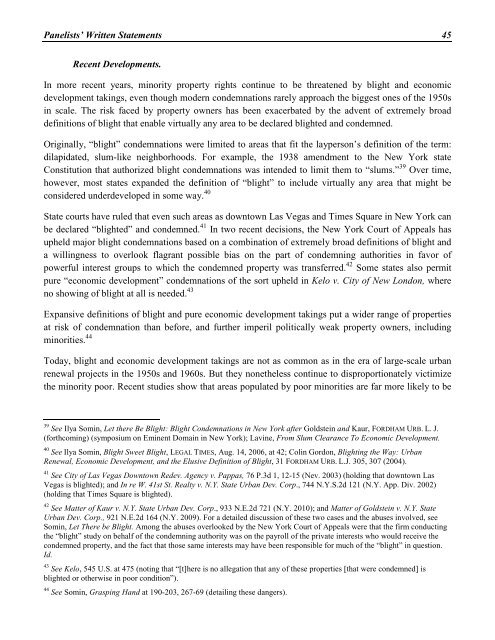Create successful ePaper yourself
Turn your PDF publications into a flip-book with our unique Google optimized e-Paper software.
Panelists’ Written Statements 45Recent Developments.In more recent years, minority property rights continue to be threatened by blight and economicdevelopment takings, even though modern condemnations rarely approach the biggest ones of the 1950sin scale. The risk faced by property owners has been exacerbated by the advent of extremely broaddefinitions of blight that enable virtually any area to be declared blighted and condemned.Originally, “blight” condemnations were limited to areas that fit the layperson’s definition of the term:dilapidated, slum-like neighborhoods. For example, the 1938 amendment to the New York stateConstitution that authorized blight condemnations was intended to limit them to “slums.” 39 Over time,however, most states expanded the definition of “blight” to include virtually any area that might beconsidered underdeveloped in some way. 40State courts have ruled that even such areas as downtown Las Vegas and Times Square in New York canbe declared “blighted” and condemned. 41 In two recent decisions, the New York Court of Appeals hasupheld major blight condemnations based on a combination of extremely broad definitions of blight anda willingness to overlook flagrant possible bias on the part of condemning authorities in favor ofpowerful interest groups to which the condemned property was transferred. 42 Some states also permitpure “economic development” condemnations of the sort upheld in Kelo v. City of New London, whereno showing of blight at all is needed. 43Expansive definitions of blight and pure economic development takings put a wider range of propertiesat risk of condemnation than before, and further imperil politically weak property owners, includingminorities. 44Today, blight and economic development takings are not as common as in the era of large-scale urbanrenewal projects in the 1950s and 1960s. But they nonetheless continue to disproportionately victimizethe minority poor. Recent studies show that areas populated by poor minorities are far more likely to be39 See Ilya Somin, Let there Be Blight: Blight Condemnations in New York after Goldstein and Kaur, FORDHAM URB. L. J.(forthcoming) (symposium on <strong>Eminent</strong> <strong>Domain</strong> in New York); Lavine, From Slum Clearance To Economic Development.40 See Ilya Somin, Blight Sweet Blight, LEGAL TIMES, Aug. 14, 2006, at 42; Colin Gordon, Blighting the Way: UrbanRenewal, Economic Development, and the Elusive Definition of Blight, 31 FORDHAM URB. L.J. 305, 307 (2004).41 See City of Las Vegas Downtown Redev. Agency v. Pappas, 76 P.3d 1, 12-15 (Nev. 2003) (holding that downtown LasVegas is blighted); and In re W. 41st St. Realty v. N.Y. State Urban Dev. Corp., 744 N.Y.S.2d 121 (N.Y. App. Div. 2002)(holding that Times Square is blighted).42 See Matter of Kaur v. N.Y. State Urban Dev. Corp., 933 N.E.2d 721 (N.Y. 2010); and Matter of Goldstein v. N.Y. StateUrban Dev. Corp., 921 N.E.2d 164 (N.Y. 2009). For a detailed discussion of these two cases and the abuses involved, seeSomin, Let There be Blight. Among the abuses overlooked by the New York Court of Appeals were that the firm conductingthe “blight” study on behalf of the condemning authority was on the payroll of the private interests who would receive thecondemned property, and the fact that those same interests may have been responsible for much of the “blight” in question.Id.43 See Kelo, 545 U.S. at 475 (noting that “[t]here is no allegation that any of these properties [that were condemned] isblighted or otherwise in poor condition”).44 See Somin, Grasping Hand at 190-203, 267-69 (detailing these dangers).


